A 'radical' 1877 window found in a RI church depicts Jesus as a person of color. What now?
For decades, the stained-glass window hid in plain sight.
In some ways, it was easy to miss. How many people really look that closely at the stained-glass windows in their church, expecting to find something extraordinary? Who could be expected to notice some unusual details when dirt and storm windows obscured the view? And once a parish has aged and shrunk to the point that it closes and it’s time to sell the building, who is even thinking about the stained-glass windows?
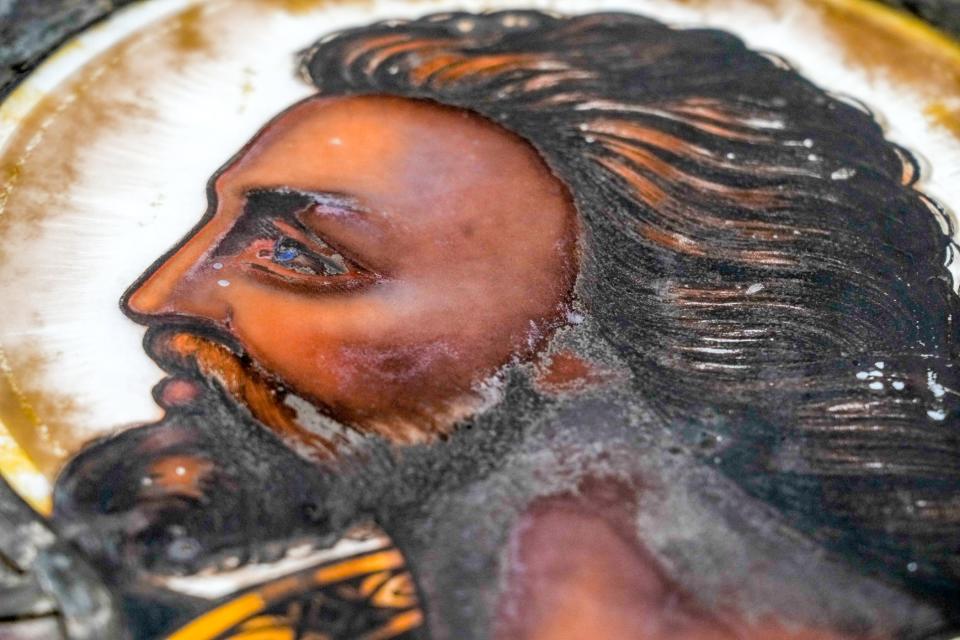
It wasn’t until years after Hadley Arnold had bought St. Mark’s Church in Warren, Rhode Island — after it narrowly avoided becoming condominiums, and after the storm windows had come off — that she, a Harvard-trained art historian and architectural designer, was able to really look at the stained glass.
And when she did, she was floored.
Because in one of the 12-foot windows, she was pretty sure she was looking at a portrait of Jesus Christ depicted as a person of color. And he was talking to two women, who were also shown as people of color.
That, in a 146-year-old stained-glass window, is virtually unheard of.
What are you looking at in the window?
The 1877 window, produced by the Henry Sharp Studio, may be one of the first public works to depict Jesus Christ and the Gospel women Mary and Martha as people of color.
“In the Sharp window we’re seeing some things that we think maybe we’ve never seen before,” Arnold said.
Since recognizing the window for what it could be, Arnold has hosted art historians, architectural historians, religious scholars, and others. Virginia Raguin, who wrote the book on America’s history with stained glass, has come to see it.
“This is a radical statement about fundamental equality of persons, and today we are privileged to have this record,” Raguin, a professor at the College of the Holy Cross, in Worcester, Massachusetts, said in an email.
The first, and arguably most radical, element of it is that all the people are depicted using brown glass. There were other windows in the church that used the milky-white glass so often used to depict Bible characters, but this was a clear and intentional departure from that. The still unanswered question is why?
But it’s not just the skin color that makes it unusual.
Most windows from this time period depict Jesus as floating in the negative space of the colored glass. But this one depicts two Bible stories in vivid detail.
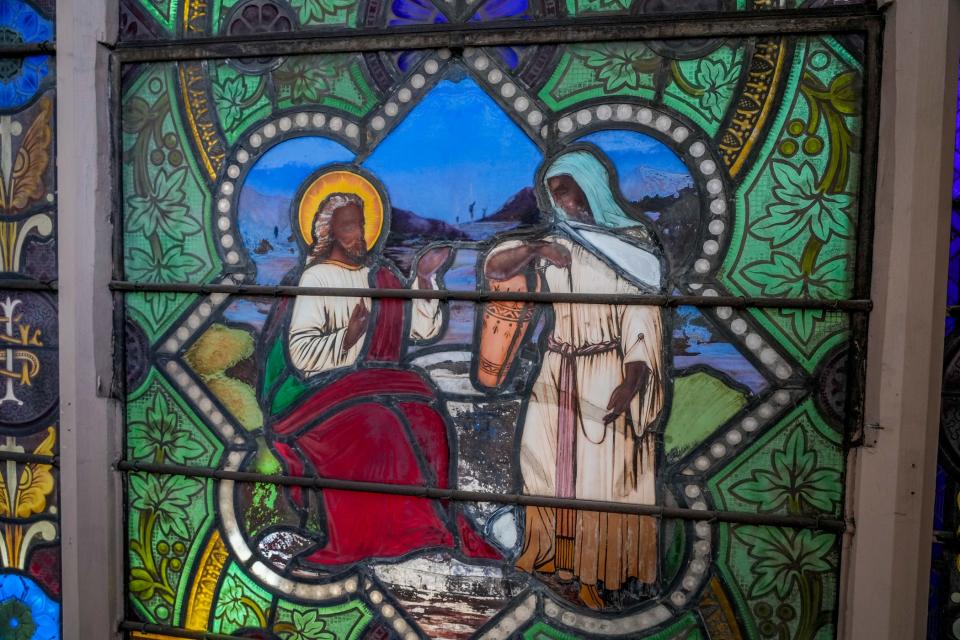
The first tells the story of Mary and Martha, sisters of Lazarus, who are hosting Jesus in their home. Mary is worshiping at the feet of Jesus, prompting Martha to scold her for leaving all the work of serving Jesus to her. But then Jesus rebukes Martha, saying that Mary has her priorities in order. Raguin’s research into the reference art that would have inspired this window revealed something unusual about this particular arrangement: All three people are shown as relatively equal.
“Women and people of color are shown as equals. No one is triumphant or commanding,” Raguin wrote. “Later I was able to identify the Biblical prints used as sources and saw that they were altered to stress equality of all people with no hierarchy of jobs between serving people food, getting water, or studying.”
In the second image, Jesus is shown talking to a Samaritan woman who is gathering water, which was a stunning Bible story because men and women were not supposed to talk in public at that time and because Samaritans and Jews were not supposed to talk to each other.
“It’s a rebel window,” said Arnold.
So far, no written records have been uncovered that explain the exact design of the window, and there are no other windows in the Sharp inventory — the prominent stained-glass shop of the day that made this window — that was exactly like this one or in this style. The style of the landscape has led to speculation that it might have even been a woman, one trained in landscape painting, who created this window as a one-off.
But to really begin to understand this window, it needs to be placed not just in a biblical context, but in a historical one — starting with the two names at the bottom of the window: Mrs. H. Gibbs and Mrs. R. B. DeWolf.
Who were Mrs. H. Gibbs and Mrs. R. B. DeWolf?
According to church records, the window was a gift from Mary P. Carr to honor the two women whose names were inscribed on the window itself.
Mrs. R. B. DeWolf is Ruth Bourne DeWolf, a white woman born in Bristol, Rhode Island, in 1787, who married into the DeWolf family late in her life. Her husband, John, was part of the infamous DeWolf slave trading empire and had been on the boats bringing Black people back from Africa to sell before he reputedly told his family he wanted out of the slave trade and retreated to his farm.
“Except, there’s really not ever getting out. It was like the mafia,” said architectural historian Catherine Zipf, executive director of the Bristol Historical and Preservation Society. “He was in deep with his brothers. It’s right there in the letters. ... He and James [DeWolf] were conspiring about all kinds of things.”
In contrast, there’s evidence that Ruth DeWolf and her sister Hannah Gibbs, the other woman the window honored, were abolitionists. The two women regularly appear in the donor rolls of the American Colonization Society, an organization that funded the transport of freed slaves to Liberia, donating money that was made in the slave trade.
But that doesn’t mean that these two women were exemplary allies of the abolitionist cause.
It's a “fraught institution, because while they're for freedom, they're also for removal,” Zipf said. “Her involvement there really doesn't necessarily imply that she is pro-freedom in the way we would understand it today. … This is all a big puddle of gray area.”
It was at the height of Reconstruction — that tense moment when the 1876 presidential election was disputed, and Rutherford B. Hayes made an informal deal to withdraw troops from South Carolina, Florida and Louisiana in what became known as the Compromise of 1877 — that Carr commissioned this piece from the Sharp studio, just a few years after Ruth DeWolf’s death.
There are no known records pertaining to Carr's commission, and no clear answers on what her motivation was or even who she was, since her name was so common. Records show a Mary Carr in Bristol and another in Warren. Women are notoriously hard to research through the written record, Zipf said, but there is one possible clue about Carr’s connection to Gibbs and DeWolf. Ironically, it comes by way of two men.
Gibbs and DeWolf funded a William Carr and a George Carr as life members of the American Colonization Society, according to Arnold’s research. Perhaps Mary is related to them, she wrote.
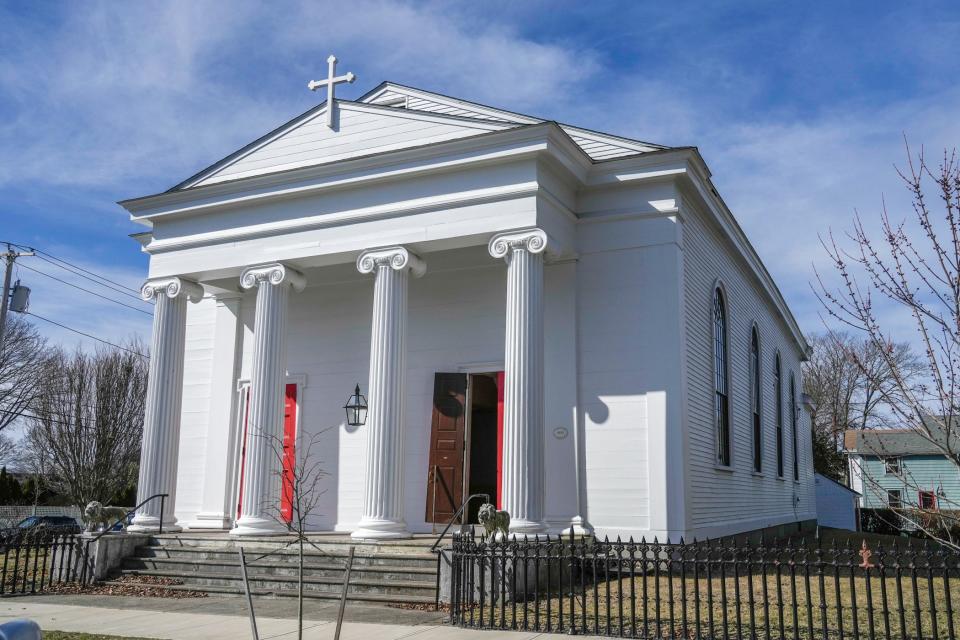
What do you do when you find a treasure like this?
Back in the present day, Arnold has many unanswered questions about the window she happened upon. There are the little things, like what kind of bird is depicted there — a dove, an eagle or a pelican? (She’s not sold on the explanation of the researcher who told her it’s a pelican.)
There are historical questions. What was the true stance of these women? Were any Black people or other people of color involved in the making of the window? Were there Black members of the parish? Why put the window in this church instead of in Trinity Episcopal Church in Bristol, which DeWolf funded in her will?
And then there are the practical questions, mainly: What do you do with a 12-foot window that you are completely convinced belongs in the public trust, to be viewed and studied, but you don’t know an institution that wants to display it?
The window is safe, but it’s already out of the wall. Arnold and her husband are in the process of transforming the church they bought into their private residence. And while she would never let it be thrown away, her future living quarters don’t seem like the best place for this piece.
And from all of these questions, two main objectives have emerged.
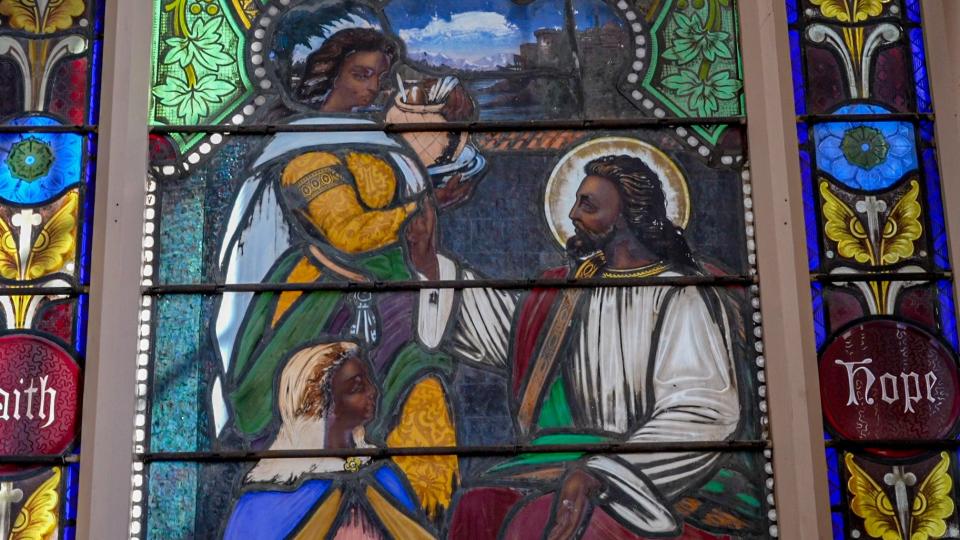
One is a belief that this window needs and deserves to be studied. On an afternoon in mid-March, she invited a group of Ph.D. students at Brown University to see the window before a round-table talk back on campus. In just an hour of prodding, she learned more about the window, and more questions were raised, about other influential glass studios that may have been involved, changes from the reference photos that made the artwork seem more African and questions about whether this piece might have been part of a movement to see “the true face” of Jesus as a man from the Middle East?
“I wish I was taking notes,” Arnold said, adding that this is why she thinks a cross-institutional, cross-discipline team should be studying the window. There’s so much to learn.
A window that also serves as a mirror
The second objective is that this piece should be displayed. One woman who came to see it was moved to tears by how personal the Bible stories depicted felt to her. And countless others have seen themselves in the work.
“When I looked at it, I said, ‘Wow, this really represents the community I serve.’ And that’s not just African Americans. I serve a large Native community as well as Latino community,” said Linda A’Vant-Deishinni, the former executive director and curator for the Rhode Island Black Heritage Society and the present executive director of the St. Martin de Porres Center in Providence. “They can see themselves in this.”
There’s a real question of where an object of this scale would go, and what its place is in history and art.
“The window, in the most wonderful way, is problematic. Is this a white story? Is this a Black story? Whose artifact is this? Whose story is this? Which history or histories are entwined here? Who’s telling whose story?” Arnold said. “I think we want to be really careful about that. … We want to try to tease out answers to those questions.”
And answering those questions has real implications that might make it difficult to find an institution to become a home for the window.
“In my opinion, the artifact should be in a major museum collection,” Zipf said. But, she added, it’s a challenge. “I think that we've sliced and diced up our museum so much that when we have something that kind of really fits in, either all of them or not, it becomes a problem.”
In the meantime, the window begs to be studied and understood, with all the messy details sorted out, but Arnold said, in the end, that just might not be possible.
“Arriving at fixed answers may not be the goal,” Arnold said. “Seeing people see themselves, whether they have all the information or not, is really powerful. There’s a place for getting all this information, but there is also a place for encounter.
“We want to put all of the pins around the wings of a butterfly so that we really understand it,” she said. “But we also still want it to be a butterfly.”
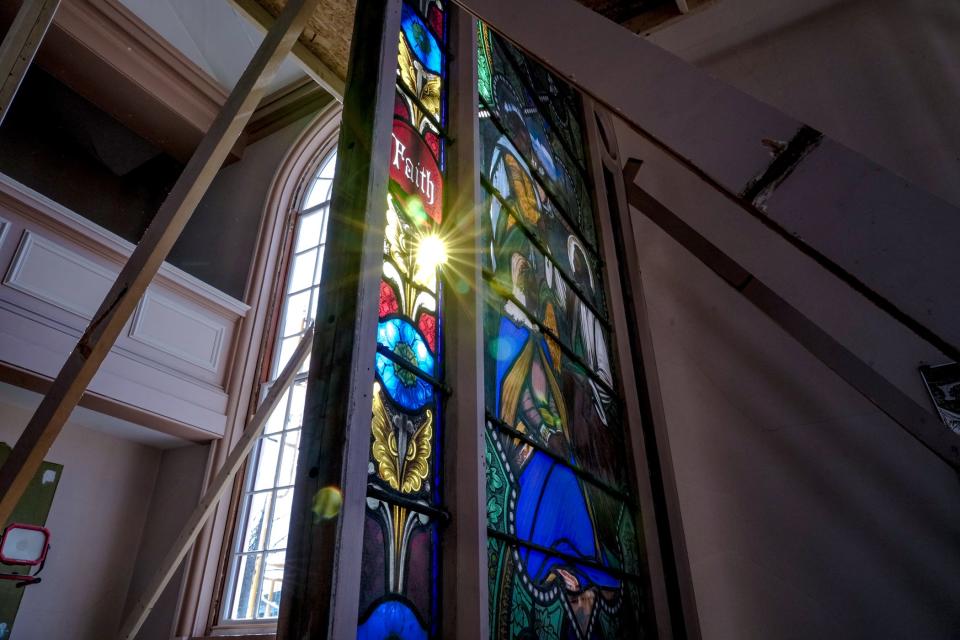
Standing in front of a piece of stained glass in a church, with the light streaming through it, what we really want is a piece of the divine that we can find ourselves in and hold on to.
Even with all the history yet to be uncovered, this window has a profound ability to satisfy that longing, and that, Arnold feels, is worth sharing.
This article originally appeared on USA TODAY: RI window could be first public depiction of Jesus as person of color

 Yahoo Sports
Yahoo Sports 